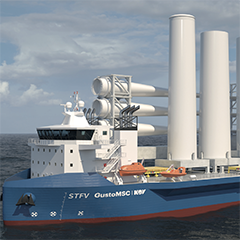The first wind turbines were often installed using existing jack-ups, originally built for civil construction or oil and gas service markets. Then the industry invested in a fleet of purpose-built wind turbine installation vessels (WTIV) jack-ups. Now, current trends and developments in the offshore wind industry are shaping the installation fleet of the future. An increasing volume of wind turbine installations and turbine weights, as well as the heavier and taller cranes require owners to modify existing jack-ups and invest in new, larger WTIV
jack-ups. At the same time, turbine installations are moving to deeper waters farther offshore, requiring jack-ups adapted for these conditions. Additionally, the offshore wind market has expanded into new territories, including Japan, Taiwan and the United States. US offshore wind faces particular challenges due to the Jones Act and a lack of suitable ports on the East Coast. Accordingly, the use of traditional self-transiting installation jack-ups is being challenged by alternative concepts, such as the new Steady Top Feeder Vessel from GustoMSC.
Addressing new challenges with an alternative model
The use of self-transiting WTIV jack-ups has been the predominant transport and installation (T&I) model for offshore wind turbine installation to date. The WTIV jack-up loads multiple turbines in port using its own onboard crane, which it then sails to the offshore wind farm. Next, the jack-up positions itself next to a turbine foundation and elevates on its legs to provide a stable installation platform. It installs the turbine components from its own deck on the turbine foundation, then jacks down, refloats and sails to the next foundation location. When the jack-up is empty, it returns to port for reloading and repeats the cycle.
An alternative to this traditional T&I model uses feeder vessels to transit components from port to site and use a separate installation vessel for the lifting operations. The feeder vessel is loaded with turbine components in port using an onshore crane or SPMTs and then sails to the offshore wind farm. The feeder vessel positions itself next to an installation WTIV jack-up that is already on site, which lifts turbine components from the feeder vessel’s deck and installs the components on the turbine foundation. Finally, the feeder vessel sails back to port for reloading to repeat the cycle, and the WTIV jack-up moves to the next location.
Typically, two feeder vessels would be used to support an installation jack-up, but one feeder vessel may be sufficient when the resulting waiting time is not a factor or three feeder vessels may be required for projects that are located far from port.



























